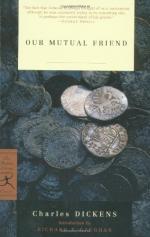|
This section contains 6,105 words (approx. 21 pages at 300 words per page) |

|
SOURCE “Depth and Surface in Our Mutual Friend,” in Essays in Criticism, Vol. 25, No. 2, April, 1975, pp. 197-214.
In the following essay, Gribble suggests that the character of Eugene Wrayburn represents Dickens's interest in the conflict between individual identity and the social persona required by a repressive Victorian society.
A note from Dickens to Forster in 1861 suggests the genesis of Our Mutual Friend:
—a man, young and perhaps eccentric, feigning to be dead, and being dead to all intents and purposes external to himself, and for years retaining the singular view of life and character so imparted, would be a good leading incident for a story.1
Readers of the story have generally agreed that the incident of John Harmon's feigned death is little more than a mechanical plot device. But the note to Forster points as well to what, in the completed novel, becomes its greatest strength. In the...
|
This section contains 6,105 words (approx. 21 pages at 300 words per page) |

|


